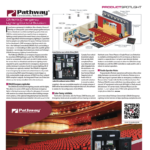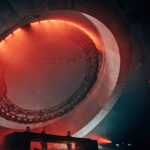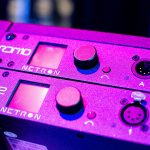For 40 years, London-based White Light has been supplying lighting equipment to the entertainment industry. Although manufacturing is not their primary focus, they have been building the VSFX image projector for some time. But they turned to City Theatrical to work with them in a joint venture to improve the product. According to City Theatrical president, Gary Fails, the VSFX had some "design challenges that White Light wanted to overcome." The VSFX has been around longer than White Light and City Theatrical, probably as far back as the early days of the 20th century. It was used in the early movie palaces to create scenic effects that moved across the ceiling of the theatre. It was also used in large scale operas and ballets of the day. Early machines used hand-wound clock motors with rubber tire drives on the face of the disk, and the speed varied by moving the motor closer or farther from the center of the disk. The disks were made of mica for its heat resistance, and they were hand-painted by artists.
Later 20th century versions of the projector used variable-speed electric motors that turned the disk by means of a rubber drive wheel on the outside edge. This produced a high gear ratio and smooth drive, but they tended to be noisy because of the loud motors. They were also unreliable because the drive wheel slipped. But when they worked, the effect could be "stunningly beautiful," according to Fails.
City Theatrical's goal was to modernize the VSFX3 by creating a "perfectly smooth and perfectly quiet stepper motor drive that could turn both very slowly and also quite fast." The new design allows for disks and lenses from older systems to be used with the new drive system. It is DMX-controlled and it accepts RDM commands to remotely change settings like the DMX address.
The VSFX3 produces large-scale projections with quality that is hard to match in this price range. It's also completely silent, so it can be put on a balcony rail, an ideal projection position that doesn't interfere with sight lines. And City Theatrical has worked to make them reliable, unlike previous models.
The VSFX is comparable in price to a low-cost video projector, which is in the medium price range for image projectors. And although it doesn't project animations like a video projector, it excels in projecting effects like clouds and abstract images such as "vapor trail."
Some automated lights have an effects disk and can project clouds, but those disks are very small compared to the 18-inch glass disk in a VSFX3. The VSFX3 projected effects move through the gate of the fixture almost horizontally, while the projection from a moving light has a slight radius to it. So the VSFX3 looks more realistic.
There is a Robert Juliat fixture that is custom-made for the VSFX and has a built-in forced-air cooling system and special lenses to project a very flat field. Alternatively, ETC's Source Four PAR is available with an enhanced aluminum reflector (Source Four PAR EA) or a metal cold mirror reflector (Source Four PAR MCM), which has a dichroic glass reflector that reflects heat to the back of the fixture and keeps it away from the glass disks of the VSFX3. The Source Four PAR MCM is not as bright as the Juliat fixture, but it is smaller, lighter, lower in cost and more readily available.
The VSFX3 has various effects, including three types of clouds (fleecy, storm and thunder), rain, snow, smoke, flame, running water and an abstract disk called vapor trail. Some disks include art glass (smoke, running water and vapor trail) that gives a very three dimensional, softly rolling or tumbling effect to the image. Gel can be added, and it is often variegated, stripped or poked though with holes to create subtle and interesting effects. Many of these effects, Fails says, are best found by experimentation. An adjustable masking shutter can be used to keep light off the proscenium or set pieces. Optional lenses include 30°, 50° and 90° lenses for different throw distances or to vary the size of the projected image. Also there is an adapter that allows the use of all Source Four lenses from 5° to 90°.


